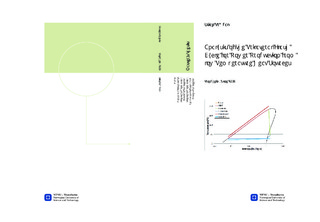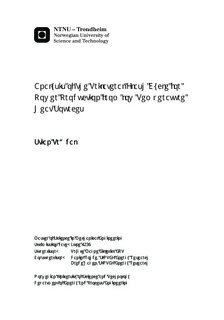| dc.description.abstract | SummaryIn this study, the Trilateral Flash Cycle (TFC) and the Partially Evaporating Cycle (PEC) have been analyzed and compared to the Organic Rankine Cycle (ORC) for power production from low temperature heat sources. This study is a continuation of the work done in my project thesis fall 2013.The ORC is a well-known technology that is in use in several plants today. The TFC and PEC on the other hand are still in a state of technical development. The biggest challenge for the TFC and PEC is the required two-phase expansion. Lately, two-phase expanders with high efficiencies have been developed, which makes the TFC and PEC economically interesting.Currently, only a few studies on the TFC and PEC can be found, and most of them are theoretical considerations. All of these studies finds the TFC promising for low temperature heat sources, which was also the findings of my project thesis. The PEC is found to be promising for smaller systems where the working fluid pump efficiency is low.The TFCs main difference from the ORC is that the heating process ends at the boiling point of the working fluid, i.e. there is no evaporation and superheating. This leads to a better temperature match between the working fluid and the heat source, such that more heat can be transferred to the working fluid. Power is produced in a two-phase expander after the heating process. The cost pr. kWh for TFC systems have been estimated to be lower than for ORC systems due to the elimination of the evaporator, separator drum, gear box, lube oil system and the fact that simpler heat exchangers can be used.In the PEC, the working fluid is allowed to be partially evaporated during the heating process. This is done in an attempt to combine the advantages of the TFC and the ORC.The ORC, TFC and PEC have been simulated in a Microsoft Excel calculation tool, using Visual Basic for Applications. The simulations include detailed heat exchanger models to calculate heat transfer coefficients and pressure losses, and two-phase expander efficiency models for the TFC and PEC. The three cycles have been simulated and optimized for maximum net power production for three cases using different heat source temperatures. Air with a mass flow of 10 kg/s and temperatures of 100, 150 and 200 °C are used for Case I, Case II and Case III respectively. Water at 20 °C is used as the heat sink. The three cases are simulated with eight different working fluids, R123, R134a, R245fa, R1234ze(E), butane, pentane, isopentane and propane with maximum heat exchanger areas of 1000, 1500, 2000, 2500, 3000, 3500 and 4000 m2. Different performance parameters are calculated and used to compare the performance of the ORC, TFC and PEC, and the different working fluids. The results show that the TFC has the lowest power production for all cases, and the largest estimated system size. Both the total heat exchanger area and expander outlet volume flow are generally higher for the TFC systems, especially for the lower heat source temperature cases. For the 100 °C and 150 °C cases the power production for the TFC and ORC is in the same range. Since TFC systems are estimated to have a lower cost than ORC systems, they can be suitable for systems with heat sources in this range when system size is not a critical factor. The PEC does not show any advantage over the ORC for the cases analyzed here. This study shows less promising results for the TFC than my project thesis and other published studies. This is mainly due to the variable two-phase expander efficiency used here, and that none of the other studies considers pressure losses in the system or calculation of heat transfer coefficients for each working fluid.A scientific paper on the main results from the study before the simulation of the PEC and inclusion of the heat exchanger models is given in Appendix C. This paper has been submitted to the journal Energy. A scientific paper on the final results of the study is given in Appendix D. This paper has been submitted to the Gustav Lorentzen Conference. | nb_NO |

